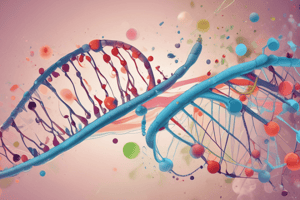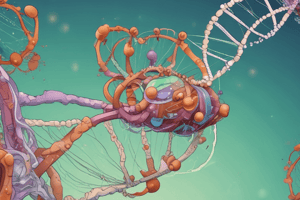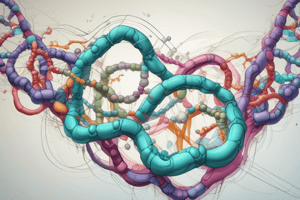Podcast
Questions and Answers
During protein synthesis, what role does tRNA play?
During protein synthesis, what role does tRNA play?
- It translates mRNA into proteins directly.
- It carries amino acids to the ribosome and matches them to codons. (correct)
- It breaks down mRNA after translation.
- It transcribes DNA into mRNA.
A dominant allele will only be expressed if an individual is homozygous for that allele.
A dominant allele will only be expressed if an individual is homozygous for that allele.
False (B)
Describe the function of the enzyme DNA helicase during transcription.
Describe the function of the enzyme DNA helicase during transcription.
DNA helicase unwinds and unzips the DNA double helix by breaking the hydrogen bonds between complementary base pairs, allowing mRNA to access the DNA sequence.
In mRNA, a sequence of three bases that codes for a specific amino acid is called a ______.
In mRNA, a sequence of three bases that codes for a specific amino acid is called a ______.
Which of the following describes the process of translation?
Which of the following describes the process of translation?
Mitosis results in four genetically different haploid daughter cells.
Mitosis results in four genetically different haploid daughter cells.
Explain how antibiotic resistance can develop in bacteria.
Explain how antibiotic resistance can develop in bacteria.
Environmental variation refers to characteristics caused by differences in ______, climate, or diet.
Environmental variation refers to characteristics caused by differences in ______, climate, or diet.
Match each term with its definition.
Match each term with its definition.
What is the primary function of RNA?
What is the primary function of RNA?
Flashcards
Genome
Genome
The entire genetic material of an organism.
Gene
Gene
A short DNA section that codes for a specific protein and controls our characteristics.
Base pairs
Base pairs
Adenine, thymine, guanine, cytosine, uracil
DNA: Deoxyribonucleic Acid
DNA: Deoxyribonucleic Acid
Signup and view all the flashcards
RNA: Ribonucleic acid
RNA: Ribonucleic acid
Signup and view all the flashcards
Transcription
Transcription
Signup and view all the flashcards
Translation
Translation
Signup and view all the flashcards
Punnett square
Punnett square
Signup and view all the flashcards
Mitosis
Mitosis
Signup and view all the flashcards
Mutation
Mutation
Signup and view all the flashcards
Study Notes
- Inheritance is the study of how traits are passed from parents to offspring.
Genetic Basics
- The genome is the complete set of genetic material in an organism.
- DNA is a double helix of two strands linked by paired bases.
- Genes are sections of DNA that code for specific proteins and control our characteristics.
- Chromosomes are long DNA strands coiled with histone proteins located in the nucleus.
DNA and RNA
- DNA and RNA are nucleic acids that carry genetic information.
- Base pairs in DNA and RNA include adenine, thymine, guanine, cytosine, and uracil.
- DNA (Deoxyribonucleic Acid) is a double helix polymer containing genetic information; it is found in chromosomes in the cell nucleus.
- DNA comprises deoxyribose sugar, a phosphate group, and a base (adenine, thymine, guanine, or cytosine).
- The sequence of bases in DNA determines the sequence of amino acids in proteins.
- RNA (Ribonucleic acid) is a single-stranded molecule responsible for protein synthesis.
- RNA, which is made of ribose sugar, phosphate, and a base (A, U, G, C), transfers code from DNA in the nucleus to ribosomes in the cytoplasm.
Protein Synthesis
- Protein synthesis occurs in two stages: transcription and translation.
- During transcription, DNA is transcribed into mRNA (messenger RNA).
- The DNA helix unwinds and unzips with the help of the enzyme DNA helicase in the nucleus.
- mRNA matches to its complementary base on the DNA strand and moves out of the nucleus.
- During translation, the ribosome translates mRNA into proteins.
- mRNA attaches to a ribosome that reads its bases in codons (groups of three).
- Start/stop codons in mRNA signal the beginning and end of the code for a protein.
- A codon codes for a specific amino acid, and tRNA has matching anticodons.
- tRNA brings amino acids to the ribosome, where they join when the base pairs on codons and anticodons match.
- Eventually forming a chain of amino acids, and the protein released is folded to form its structure when the stop codon is reached.
Genetic Traits and Inheritance
- The genotype is the combination of alleles that control a characteristic.
- The phenotype is the physical characteristic that can be observed.
- A dominant allele will express its phenotype regardless of whether the genotype is homozygous (when the two alleles of a gene are the same) or heterozygous (when the two alleles of a gene are different); it only needs to be inherited once.
- A recessive allele needs to be inherited from both parents to show up in the phenotype.
- Codominance is the equal expression of equally dominant alleles in the phenotype.
- Polygenic inheritance occurs when phenotypes are controlled by more than one gene, allowing for a wide range of combinations of phenotypes.
- Monohybrid inheritance occurs when phenotypes are controlled by a single gene.
Genetic Diagrams
- A Punnett square shows combinations of alleles in offspring, always showing the dominant allele first.
- A family pedigree traces the pattern of inheritance of characteristics through generations.
Cell Division
- Mitosis is cell division that produces two genetically identical diploid daughter cells for growth, repair, cloning, and asexual reproduction; it undergoes one division.
- During mitosis, the cell grows, and all 46 chromosomes are replicated (96 chromosomes).
- The cell divides, and the chromosomes split, forming the daughter cells.
- Meiosis is cell division that produces four genetically different haploid daughter cells for the formation of gametes to increase genetic variation; it undergoes two divisions.
- In meiosis, the cell grows, and all 46 chromosomes are replicated (96 chromosomes).
- The cell divides into two cells, each with 46 chromosomes, which then divide into four haploid cells, each with 23 chromosomes.
Variation
- Variation refers to differences in DNA sequences among individuals within the same species.
- Gametes are genetically different due to meiosis.
- Fertilization of gametes is random and increases genetic variation.
- Genetic variation means phenotypes depend on inherited alleles from parents.
- Environmental variation means characteristics are caused by differences in lifestyle, climate, or diet.
- Combined, genes decide inherited characteristics, and the environment affects how they develop.
Mutations
- Mutations are rare, random, and spontaneous changes in genes (DNA) that can be inherited and can occur in any chromosome.
- Mutations alter the base pair sequence in DNA, which can code for different proteins, leading to different proteins being made, which affects the phenotype.
- Effects of mutation are most often none or small, but rarely have a significant effect.
- Increasing mutation rates can be caused by ionizing radiation or chemical mutagens that damage bonds and cause changes in base sequences.
- Increased rates of mutation can cause cells to become cancerous.
Natural Selection
- Evolution is the cumulative change in the genetic makeup of a population over many generations, based on the concept of natural selection.
- Variation exists within species, caused by different genes from sexual reproduction and mutations.
- Some phenotypes give individuals a survival and reproductive advantage.
- Individuals with advantageous genes are more likely to pass their genes on at a higher rate, and over generations, the advantageous phenotype becomes the norm.
Antibiotic Resistance
- Antibiotics are chemicals that kill or inhibit the growth and reproduction of bacteria.
- Antibiotic resistance occurs when bacteria become resistant to antibiotics, reproducing and evolving in short time spans.
- Variations caused by mutations occur, which can cause bacteria to be resistant.
- These resistant bacteria do not die when treated with antibiotics, reproduce with less competition, and pass on their genes for antibiotic resistance, leading to a whole population of bacteria becoming antibiotic resistant.
- Causes of antibiotic resistance include unnecessary overuse of antibiotics, such as treating non-serious infections, failing to finish prescribed courses, or routine use in agriculture.
- The effect of antibiotic resistance is that it becomes harder to find working antibiotics, and infections become harder to control, so it is important to always finish a course of antibiotics; otherwise, the worse bacteria will be left and reproduce, and become resistant to that antibiotic.
Studying That Suits You
Use AI to generate personalized quizzes and flashcards to suit your learning preferences.




